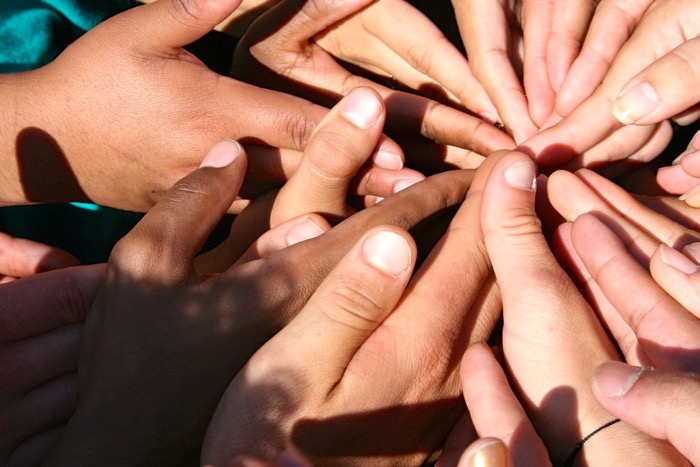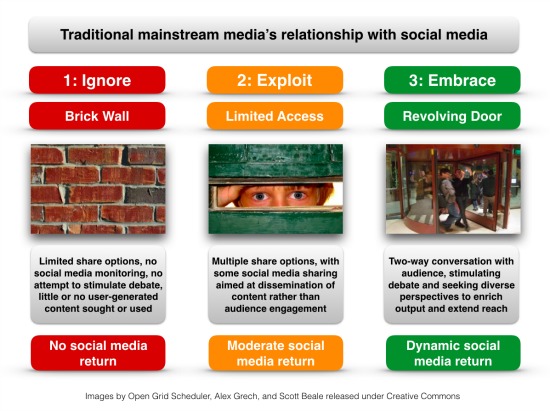
Does your media organisation have a social media strategy. Does it reach out and connect with your audience?
There are many ways media organisations respond to social media, but here are three.
Media Helping Media recommends the third and final attitude in this list, but first check which one fits your media organisation and then think through what are can do about it.

1: Ignore
The broadcast or publish at model
-
-
- Social networking is a distraction that has nothing to do with traditional media.
- It is a plaything for trivial exchanges and is not for journalism.
- Keep out. Our content is our content. We know best.
- We will refer to a social network trend in a story but only as an illustration and only if supplied in wires copy.
- It’s our job to provide information. We are the professionals.
- If there is a piece of user-generated video, an image or a comment on the wires, we may refer to it or include it, but, come on, we are journalists and they are just amateurs.
- We’ve been trained, and we have standards – they haven’t. Keep them in their place.
- Stick to the wires, press releases and getting our own reporters to cover diary events and our correspondents to cover their specialisms.
- Don’t be distracted by the social media noise out there.
-
Result
A we-know-best attitude that fails to acknowledge changing audience behaviour and sees the audience as consumers rather than part of the news process.
While this is going on, an increasingly informed and influential middle media is taking over the role of informing the public debate with people-focused stories published on blogs and distributed via the social networks that reflect diversity of opinion and offer perspectives which are often lacking in heavily-controlled news environments.
Prognosis
This model is in its death throes or already dead.
2: Exploit
The engage-with on our terms model
- We realise social networking is popular, we understand the benefits of viral marketing and distribution, and we see it as a way to disseminate our material to a wider audience.
- Our sales and marketing department is on the case.
- Every now and then we are happy to refer to social media in our bulletins and stories, and sometimes it might be part of a story, but only in terms of showing a trend or in cases where social media offers access to voices we would not normally reach.
- Keep social media elements in the “and finally” part of the bulletin.
- If presenting on camera and talking about social media, offer that smile, nod and wink to suggest it’s all a bit of fun and not to be taken too seriously.
- When reporting on radio, make sure there is a tone to your voice that indicates to the audience where the line exists between the facts we have uncovered and the information that has been found via social media.
- Our use of social networking must be on our terms only.
- When referring to social media be sure to attribute any information as unconfirmed and ensure there is an element of doubt until we can confirm with two independent sources.
- When inviting social networking participation on any story, whether in the form of comments or forum discussions etc, be sure to keep control of the agenda.
- Only invite user input on the stories we want covered and only publish the comments which fit in with our view of how the story should develop.
Result
Containment, with a firm grip on the amount and scope of social networking in output. Regular references to social media as a phenomenon and an increasing awareness of its use as a possible newsgathering tool, but the main thrust of output is still based on wires, diary events and reporter/correspondent input from newsroom meetings, their contacts and their specialist beats.
Prognosis
This “engage with on our terms” model will work well as a part of a transition from the “broadcast/publish at” model, but is not a recommended survival strategy.
3: Embrace
The let loose to hold tight model
- We see social networking as central to all we do.
- By tapping into this rich vein of stories, perspectives, and first-person witness and thought we are able to enhance our output.
- This enriches our news and current affairs and highlights real concerns.
- It adds genuine comment and ensures that our output is relevant and revealing.
- There must be a social networking element in all stories.
- If we don’t reflect what is going on in society we are limiting the scope of our coverage and reducing our relevance to our audience.
- We must view all bloggers and social networkers as potential stringers.
- We must monitor social media at all times and build a new network of trusted contacts who we can turn to and who can turn to us.
- We need to get to know the network of contacts belonging to those social networkers we turn to the most and build on that, too.
- Crowdsourcing is using information, or effort, contributed by the general public. We must harness this resource.
- Ideally, we must aim to move away from a wires-led and events-led news agenda and shift the focus over to the audience.
- All our content is there for our users to take away to their preferred social networking space where they can interact with their contacts and add their own context and analysis – and we must always look for ways to bring this back into our newsgathering and news production processes.
- No story is complete without a social networking element.
- In a breaking story situation, where we are feeding the social networks with updated information, we must be sure to be part of, visit and tap into those networks to monitor the discussion and reflect that in our output.
- We must not rely just on pushing our updates to Facebook and Twitter. We must be part of the social media conversation so that we can stimulate the debate, ask questions, find answers and uncover new information.
- All journalists must have social networking aggregation tools on their desktops and monitor updates at all times.
- As with all information, we can refer to it but confirm it only when we have two independent sources.
Result
- Fresh, relevant, user-focused news covering the issues that concern the target audience and wider audience.
- A rapid growth in viral news distribution (the audience sharing the content for us), brand influence and trust.
- Increased traffic back to the news website.
- Increase in fans on the media organisation’s Twitter page, Facebook page, YouTube site and all other social network sites – again with associated increases in traffic to all the brand’s online properties.
- Most importantly, a welcome to the social networking party – not as a gate-crasher, but as an informed source of information.
Prognosis
A healthy strategy, adapting to changing audience behaviour, letting loose of content to hold tight to the audience, while, at the same time, reflecting the priorities, concerns and thinking of that audience.








